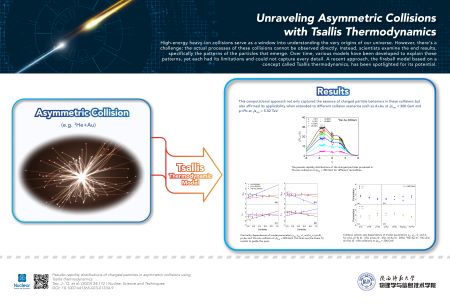博文
[转载]陕西师范大学郑华研究员:非对称碰撞中的粒子模式——Tsallis热力学方法
||
Article title: Pseudo-rapidity distributions of charged particles in asymmetric collisions using Tsallis thermodynamics
文章标题:使用Tsallis热力学研究非对称碰撞中带电粒子的赝快度分布
DOI: 10.1007/s41365-023-01334-9
One sentence summary:
一句话概要:
This research introduces a significant thermodynamic model to decode the complex patterns of charged particles in asymmetric collisions, offering a universal tool for understanding fundamental processes in high-energy physics.
这项研究提出了一个重要的热力学模型,用于解码非对称碰撞中带电粒子的复杂模式,为理解高能物理中的基本过程提供了一个通用工具。
Keywords:
关键词:
Tsallis thermodynamics, Fireball model, Pseudo-rapidity distribution, Heavy-ion collisions, Charged particles
Tsallis热力学, 火球模型, 赝快速度分布, 重离子碰撞, 带电粒子

The Novelty (What)
创新性(主要内容)
In analyzing collisions like Au and 3He+Au at √sNN = 200 GeV, this research uncovered the robust capability of fireball model (based on Tsallis thermodynamics) to forecast and interpret patterns of particles emerging from the collisions. This computational approach not only captured the essence of charged particle behaviors in these collisions but also affirmed its applicability when extended to different collision scenarios such as d+Au at √sNN = 200 GeV and p+Pb at √sNN = 5.02 TeV. The findings offer a promising and universal framework for understanding a variety of collision systems. As its versatility and accuracy become evident, the future might see this model as a cornerstone in deciphering more complex collision dynamics.
在分析像金和3氦+金在√sNN = 200 GeV的碰撞时,本研究揭示了基于Tsallis热力学的火球模型预测和解释碰撞中产生的粒子模式的强大能力。这种计算方法不仅捕捉到了这些碰撞中带电粒子行为的本质,而且还证实了其在扩展到不同碰撞场景时的适用性,例如氘+金在√sNN = 200 GeV和+铅在√sNN = 5.02 TeV的案例。这些发现为理解各种碰撞系统提供了一个有前景且通用的框架。随着其多功能性和准确性变得明显,未来可能会看到这个模型成为解读更复杂的碰撞动力学的基石。
The Background (Why)
研究背景(主要原因)
High-energy heavy-ion collisions serve as a window into understanding the very origins of our universe. In simple terms, these are like powerful fireworks on a microscopic scale. However, there's a challenge: the actual processes of these collisions cannot be observed directly. Instead, scientists examine the end results, specifically the patterns of the particles that emerge. Over time, various models have been developed to explain these patterns, yet each had its limitations and could not capture every detail. A recent approach, the fireball model based on a concept called Tsallis thermodynamics, has been spotlighted for its potential. This paper's thesis is to further validate this fireball model, especially for a kind of collision where the two colliding entities are not identical, termed as "asymmetric" collisions. By doing so, the researchers aim to provide a more comprehensive tool that can describe these collision aftermaths better than ever before, filling the gaps left by prior models.
高能重离子碰撞被视为理解我们宇宙起源的一扇窗。简单来说,这些碰撞就像是微观尺度上的强大烟火。然而,目前存在一个挑战:这些碰撞的实际过程无法直接观察。在这些限制下,科学家只能够检查最终结果,特别是涌现出来的粒子的模式。随着时间的推移,虽然科学家已经开发了各种模型来解释这些模式,但每个模型都有其局限性,那就是无法捕捉到每一个细节。最近,一个基于Tsallis热力学概念的火球模型因其潜力而受到关注。本研究的论点是进一步验证这个火球模型,特别是对于射弹粒子与靶粒子不是全同的“非对称”碰撞。通过这方法,研究人员旨在提供一个比以往更为全面的工具,可以更好地描述这些碰撞后结果,填补先前模型留下的空白。
The SDG impact (Big Why)
SDG影响力(研究意义)
Advancements in fundamental research play a pivotal role in shaping the future of education and innovation on a global scale. With a rapidly changing global landscape, advancing our grasp on fundamental sciences becomes ever more critical. This research is contributing directly to the SDG of Quality Education (UNSDG 4) for highlighting the importance of advanced learning and the role of innovative scientific research. Additionally, by pushing the boundaries of scientific discovery, this research aligns with Industry, Innovation, and Infrastructure (UNSDG 9).
研究的进步对于塑造教育和创新的未来发挥着关键作用。随着全球格局的快速变化,提高人们对基础科学的掌握变得更加重要。这项研究强调了先进学习的重要性及创新科学研究的作用,直接促进了联合国可持续发展目标中的优质教育(UNSDG 4)。此外,通过推动科学的界限,这项研究也与产业、创新和基础设施(UNSDG 9)保持一致。
https://blog.sciencenet.cn/blog-3474219-1433093.html
上一篇:[转载]快速核测量促进清洁能源